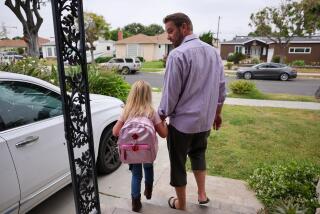Teachers from low-performing schools face stigma on job search
In a bizarre game of musical chairs, nearly 1,000 Los Angeles teachers — who are guaranteed jobs somewhere in the school system — have been hunting for a school that wants them. And hundreds of them have to counter a stigma that they are undesirable castoffs, because they previously worked at low-performing schools that are being restructured.
These teachers are from eight schools that are undergoing shakeups intended to bring in new talent, shed previous instructors and administrators and fundamentally change the academic culture. It’s a theory of reform embraced by the Obama administration, though such efforts have a mixed record nationwide.
“This whole process has been disheartening and humiliating,” said Jordan High history teacher Aureliano Nava in an email. Like nearly every other Jordan faculty member, he isn’t returning there. “I have no doubt that we are being pre-judged and perceived as bad teachers for, after all, don’t we come from a failed school?”
For months, Los Angeles Unified School District officials have attempted to deal with a budget shortfall that resulted in layoffs of nearly 2,000 teachers, counselors, nurses and other professional staff. They were out of a job as of June 30.
But 1,000 others have been hunting for positions because they lost their former jobs but have enough seniority under the union contract to guarantee them employment. More than 300 chose to leave a particular school or were let go from a school undergoing reorganization. Another 625 landed in this pool because of declining enrollment at their former schools, for example, because their administrative or central office job was cut or because the Board of Education voted to turn over several campuses to independently operated charter schools, which can do their own hiring.
Odds are that these teachers have or will get most open jobs because L.A. Unified has frozen most new hiring. While officials prefer for schools to choose their own hires, the district will also assign teachers to specific schools; teachers who cannot find a job will work as substitutes at their regular pay rate.
The first of the eight schools to open with a mostly new staff was Huntington Park High, which opened on Tuesday. It operates year-round because of overcrowding. Only 30% of its staff returned, and district officials were still conducting job interviews heading into the Fourth of July weekend.
In three job interviews, including one at Huntington Park, “all seemed to be going well, up to a certain point,” said Nava, who is 52. “Attitudes change upon realizing that (1) I am a displaced teacher from Jordan. (2) I was Jordan’s [union] chair. My Jordan colleagues have shared similar experiences with me.”
Only nine Jordan teachers, about 12%, are returning to the Watts school.
L.A. Unified Supt. John Deasy warned principals, in an internal memo, to start hiring teachers who are entitled to positions. He also tacitly acknowledged concerns about the quality of some of these teachers.
“We must all work together to ensure that teachers who do not belong in our district are dealt with through the disciplinary and dismissal process,” he wrote. In the future, he vowed to ensure “poor performers” are not moved from school to school.
Alex Bodnar lost out to declining enrollment at Manual Arts High School. At a recent job fair at the district’s downtown headquarters, he scanned for leads along a glass wall where each school had a folder posted to hold resumes, with job openings listed on the outside. Jordan was hiring in English, math, social studies and special education. (Special ed is one of a handful of areas where teachers are in such short supply that schools can hire from any pool of available teachers.)
Bodnar, 36, has three years of experience as a high school art instructor and 10 years of teaching total, enough seniority to retain employment, but not enough to remain at Manual Arts, he said.
Bodnar said he is the main provider for his family “so it’s a scary situation.”
Dozens of teachers stood chatting nervously or sat on the edge of planters waiting to be called for interviews.
“We’re out here like cattle,” said veteran special education teacher Dave Sievers, 46, who didn’t apply to return to Huntington Park. “They don’t even have chairs for us.”
Jefferson High Principal Michael Taft needed to replace a retiring librarian and a math teacher who is likely to move.
“I’ve interviewed three math teachers, and they were all very high-quality teachers,” Taft said. “I try to tell them what is going on with our [reform] plan…what we’re trying to accomplish.”
San Fernando Valley parent Susan Kovinsky, part of a hiring team for an elementary school, was less impressed at the hiring fairs.
“Trying to find ‘young and bubbly’ to motivate and teach our youngest minds is like looking for a needle in a haystack,” she said. “I met teachers that just seemed like they were desperate for a job, and yet it was obvious they had no real desire to be a part of this decimated system anymore.”
The situation clearly had worn down one 66-year-old science teacher who considers himself effective in the classroom but finds his enthusiasm waning.
“Before, I planned on working as long as I felt good. Now, I’m so fed up I just want to put in my time,” said the teacher, who asked not to be named for fear of alienating a school that might take him on. “I’m staying here because of the medical benefits.”
More to Read
Sign up for Essential California
The most important California stories and recommendations in your inbox every morning.
You may occasionally receive promotional content from the Los Angeles Times.











